Insect & Disease Conditions Update
In this time for reflecting on the year past and looking ahead to the new year we have included a little of both in this bulletin.
First, in looking back, the 2019 Forest Health Highlights, produced for the United States Forest Service, is now available on-line. In the publication you will find, from the perspective of early November 2019, a summary of forest resources, an aerial survey overview and information on the 2019 notable forest insect and disease issues. This publication can be found at the following link: Summary Updates on some issues in the linked highlights and additional items are found in the sections below.
Looking ahead, we plan to resume the Conditions Reports in April, with the budding of the trees in southern Maine. In the meantime, this and past issues are archived on our Conditions Reports Index Page. Additional electronic updates may be shared to our electronic lists between now and April, but may not be mailed to subscribers of paper versions of the reports.
As always, you can reach us with concerns or observations about forest health at: https://appengine.egov.com/apps/me/dacf/mfs-tree-ailment, or (207) 287-2431.
On behalf of the Maine Forest Service, Forest Health and Monitoring, we wish you and your trees all the best in this new year.
The year 2020 has been declared the “International Year of Plant Health” by the United Nations General Assembly (http://www.fao.org/plant-health-2020/en/). In this time of contemplating resolutions for the New Year, we can resolve to add to the impact of this declaration. How?
Individuals can and do make a difference in the health of our forests and trees.
The Report a Tree Program is an online reporting tool being developed by the Waldo County Soil and Water Conservation District in partnership with Anecdata. It has many promising applications to several aspects of forest health and is expected to be fully functional by June 1, 2020. Located on the Anecdata citizen science site, the tool has options for reporting symptoms and signs of forest pests, trees with potential resistance to insect and disease, and trees that have potential for adaptive reforestation/assisted migration. There is also a handy phone app. Those wishing to participate in this citizen scientist effort need to register on the Anecdata site and create an account before adding reports and observations. Any questions about the tool and its use can be directed to Aleta McKeage, Technical Director of the Waldo County Soil and Water Conservation District: Aleta McKeage: aleta.waldosoilandwater@gmail.com. The following is a link to Report a Tree on Anecdata: https://www.anecdata.org/projects/view/623.
Revisions are planned for the hemlock woolly adelgid and the emerald ash borer quarantines under the Maine Bureau of Agriculture rules. The proposed changes are drafted and will be posted at the Secretary of State site, https://www.maine.gov/sos/cec/rules/index.html; expected later this week. In both cases, the proposed changes are due to expansions of the known distributions of the invasive insects targeted by the rules. In the case of hemlock woolly adelgid, an expansion of the area under regulation along the coast through Hancock county will be proposed. In the case of emerald ash borer, addition of Cumberland County and the five southernmost towns of Oxford County will be proposed.
 Public feedback on the proposals is encouraged. Comments can be submitted in writing to:
Gary Fish State Horticulturist Maine Department of Agriculture, Conservation and Forestry 28 State House Station Augusta, ME 04333-0028 gary.fish@maine.gov 207-287-5576 Fax
Any comments considered in revision of the rules must be submitted in writing to Gary. However, please feel free to reach out with questions (State Horticulturist, gary.fish@maine.gov 207-287-7545; State Entomologist, allison.m.kanoti@maine.gov, (207) 827-1813).
LD 1761 is slated to be among the subjects of a work session at the Legislature’s ACF committee on January 21st. This bill was requested by the department after the drafting of the Emergency Order related to the first detection of emerald ash borer in Maine. When that Emergency Order was drafted, the AG Office recommended the Department pursue placement of penalties under Title 12 M.R.S. § 8305 and § 8306. Subsection 8305 gives the director of the Bureau of Forestry authority to control movement of plants, plant parts, wood or wood products that may cause the introduction of a dangerous forest insect or disease; § 8306 gives the Director authority to enact quarantines if they are determined to be necessary to protect forest health and they do not already exist elsewhere, specifically under the authority of the Bureau of Agriculture in Title 7.
These authorities provide tools to slow the spread of or contain damaging agents of the forest and are important to help mitigate impacts to forest health from introduced insects and disease agents.
Background from the last session can be found in the on-line documents.
https://legislature.maine.gov/legis/bills/display_ps.asp?LD=1726&snum=129
Questions can be directed to allison.m.kanoti@maine.gov or (207) 827-1813.
Image: Proposed additions to the Hemlock Woolly Adelgid Quarantine Area in Maine.
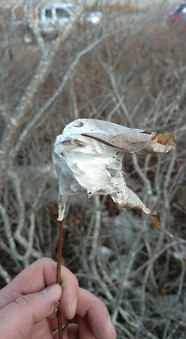
Browntail Moth (Euproctis chrysorrhoea) – Winter has finally settled in and so have browntail caterpillars, snug in their winter webs. We are gearing up to begin our annual winter web survey of Maine. Throughout this survey our staff members travel the roads within infested areas and estimate the number of webs per tree. They collect data points that are used in addition to aerial survey data to construct a risk map that is made available to the public.
If you find webs within reach, now through mid-April is the time to clip and destroy the webs by soaking them in soapy water or burning them. Winter is the best time to clip webs due to the low risk for exposure to the caterpillars’ toxic hairs, caterpillar dormancy, as well as the high visibility of webs. Viable webs will be at the tips of branches and will shine and glimmer in the sun due to the fresh white silk that holds the web together. Although risk of hair exposure this time of year is low, we always recommend that people take proper precautions, especially sensitive individuals, since remnants of cocoons and cast skins of caterpillars can be present in the trees. For more information, see the video resource for clipping webs on our website: https://www.maine.gov/dacf/mfs/forest_health/invasive_threats/browntail_moth_info.htm
Photo: Browntail moth winter web in Deer Isle.
|
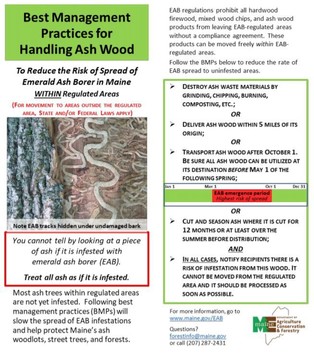
Emerald Ash Borer (EAB) (Agrilus planipennis) – The Maine Forest Service conducted several bark-peeling workshops throughout the state during November and December. Along with numerous landowners, volunteers and other cooperators, we examined trap trees (girdled the previous spring) for signs of EAB. Except for the trees reported in the previously linked highlights, no girdled trap trees were found to be infested, including several trees from quarantined towns in northern Aroostook County. This may indicate that EAB is spreading more slowly in Aroostook County from its smaller point source than in York County, where infested towns are at the leading edge of a large infestation.
While you are out in Maine’s winter woods this year, look for evidence of EAB, and if you suspect you have found it, please report it, regardless of where in Maine it is. This is the time of year when activity of woodpeckers seeking out overwintering larvae may reveal previously undiscovered EAB infestations. When the birds are going after EAB, there is very little excavation of the wood, almost all activity is concentrated on the outer bark of the tree. As a result, affected trees have large or small patches of lighter bark where more weathered bark has been removed. Woodpeckers will also seek other native and established bark beetles and woodborers, but we appreciate reports of high woodpecker activity in ash that you suspect may be related to EAB.
Two recently drafted publications with additional guidance on slowing the spread of EAB added to the department’s website, www.maine.gov/eab. These include best management practices for handling ash within quarantine areas, and guidance for solid waste handlers. Both can be found under the “Caring for Ash Trees & Managing Forests” section of the EAB website.
Management of forest ash - As a final note on EAB, we and our partners share many details about invasive forest pests with the public and professionals. Our goals are to raise awareness of the pests, encourage preparation and informed responses and increase the likelihood of detection. The information is depressing. It is understandable that the reaction to this news might be to cut all or most of the trees at risk.
Harvesting to eliminate entire species of trees from an area can further threaten the future of those at-risk tree species. It may reduce the variability of the genetics in our trees—variability that may hold the key to the future of the species. It could speed the spread of the problem. Finally, if a tool becomes available to manage damage from the pests, like the parasitic fly which is helping oak survive the arrival of winter moth, those trees and their progeny will not benefit from the work. We caution against reactive or pre-emptive harvest of all or most of the trees that could be or are impacted by those pests.
The arrival of EAB does make a difference in how people manage ash in their woodlands. However, it is important to plan for a future with the possibility of some ash. Consider leaving ash that are too small to be harvested for sawlogs, especially those of good form and health. It may make sense to cut more ash than if EAB were not in the region; but you are encouraged to do so with an eye to a future with ash. In particular, there is evidence that a portion of ash, especially white ash, are resistant and/or tolerant to EAB. Harvest of “all ash trees,” or even most, will eliminate any hope of significant ash in the forest after EAB moves through the state. More detailed recommendations can be found at www.maine.gov/eab under “Caring for Ash Trees & Managing Forests.”
|

Winter moth (Operophtera brumata) – In September we placed an emergence cage in Boothbay Harbor containing the biocontrol for winter moth, Cyzenis albicans. Boothbay Harbor was selected for the release site for this very important fly due to the high population of winter moth which caused a great deal of defoliation there this past spring.
December saw the deployment of over 60 pheromone traps from Kittery to Bar Harbor as part of efforts to monitor winter moth populations along the coast of Maine. The traps are baited with a mating pheromone to lure in male moths (the females are incapable of flight due to their greatly reduced wings). Those traps are being retrieved this month.
Photo: Cyzenis albicans emergence cage.
|
Spruce Budworm (Choristoneura fumiferana) – Now that the dust has begun to settle (i.e. moth scales from counting all the trap samples), we are starting to have a better idea of how the 2019 Maine spruce budworm (SBW) situation shaped up. The catches corroborate the models which indicated that Maine was in the path of several large flights of budworm from Canada. The maps below, built on painstaking counts of more than 400 samples, clearly illustrate an increase in moths captured in 2019.
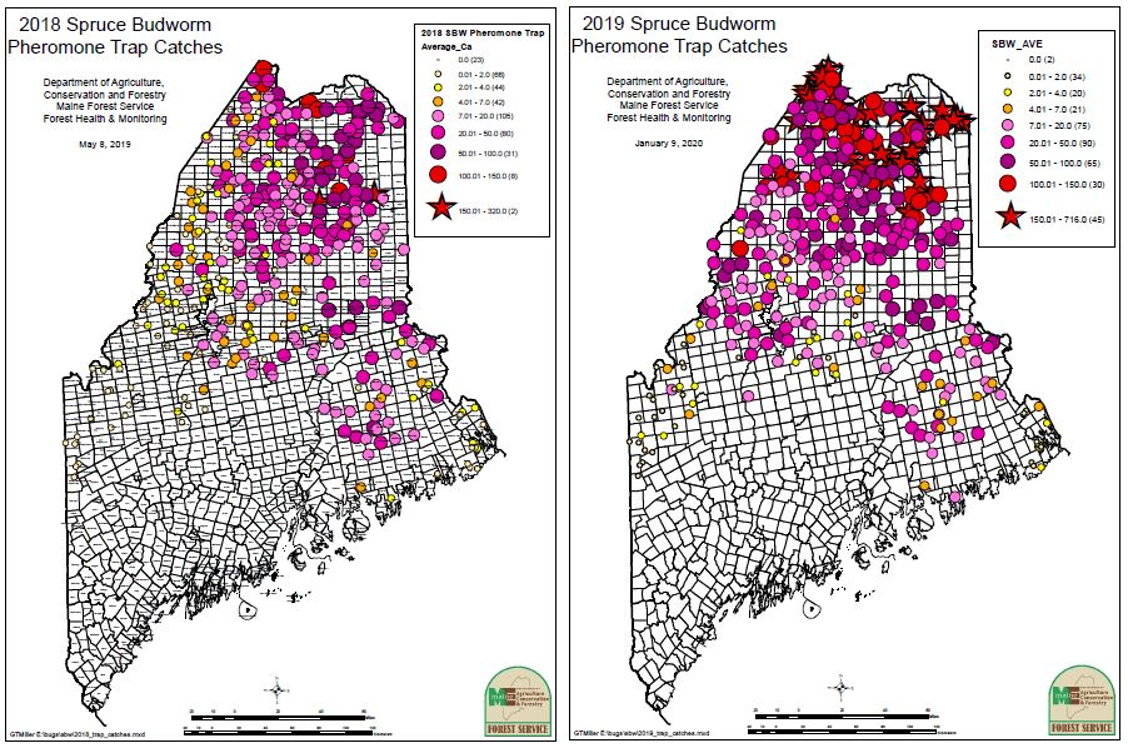 This is just one piece of the population puzzle, since male moths are the ones attracted to the pheromone baited traps. 2019 defoliation and larval (L2) survey data will help us better understand what these numbers mean regarding 2020 populations of budworm.
Incomplete data from branch samples processed by CFRU to detect defoliation of SBW host trees during 2019 has revealed that some defoliation occurred (this measure captures defoliation from all sources). As in previous years, this defoliation was not present on the landscape to a degree where it was visible during aerial or casual ground surveys.
Regarding overwintering larvae, L2 populations continue to be low in those samples processed by the Canadian Forest Service in Fredericton to date. Complete data from that project is expected soon and will provide the best measure of the current generation of budworm.
The early results from defoliation and L2 surveys are promising, especially considering high trap catches, but it is still too early to make any definitive predictions about what the larval population will look like this summer. Complete results of 2019 SBW monitoring activities will be released in a separate report later this winter.
Image caption: Comparison of spruce budworm pheromone trapping results maps from 2018 and 2019 showing a notable increase in average trap catches in 2019.
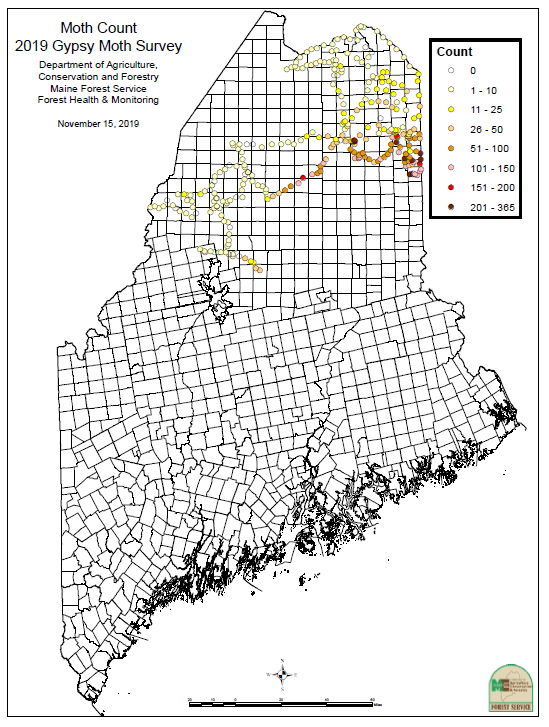
Gypsy Moth (Lymantria dispar) – Although gypsy moth is still absent from much of the northernmost portions of populated Maine and much of the northwest quadrant of the state, it has slowly continued to spread throughout the state. Based on this fact, as well as public input during the rulemaking process, the decision was made in 2019 to expand the quarantine to encompass the whole state. Beginning this year, MFS will no longer be conducting a formal survey using pheromone traps to monitor spread of the gypsy moth.
MFS will continue to monitor for gypsy moth to the best of our ability and make use of egg mass surveys and public reports to determine where gypsy moth may pose problems in the future. Maine has been fortunate to avoid major damage in recent years, as other states in New England such as Massachusetts and Connecticut have suffered severe defoliation and are now experiencing substantial oak mortality.
If you live in Maine and notice an abundance of new gypsy moth egg masses in your area, please contact Mike Parisio at michael.parisio@maine.gov or (207) 287-7094.
Image caption: Map illustrating number of male gypsy moths caught in MFS pheromone traps throughout northern Maine in 2019
|
Animal damage – Feeding by voles, rabbits/hares and deer can deform and even kill young trees. Wrapping the base of trees or applying tree guards all the way to the ground level may be the difference between a healthy or dead seedling/sapling by spring. Voles burrow under the snow and feed on the thin bark of young trees (in the horticultural environment, newer plantings). If voles or rabbits/hares eat the bark all the way around the main stem, trees will be girdled. While these girdled trees may leaf out in spring, they will very likely die soon after. Where rabbits and hares are common, protecting trees a few feet above the snow line is important too, since rabbits/hares are capable of standing on their hind feet to eat buds, twigs and bark of young trees. Deer present more of a challenge due to their height, but may be deterred by commercial and home-remedy repellents.
Forest Inventory Updates – Maine’s Forest Inventory unit is an integral part of the Forest Health and Monitoring Division. Regarding forest inventory progress, recognition is due to the staff who consistently conduct excellent work on completion of this important project. In the best and worst of days and all days in between, in all corners of the state, they conduct their work efficiently, professionally, and well. The last plot of Cycle 9 Sub Cycle 1 was completed on 12/30/2019 with the last plot uploaded to the US Forest Service database on 1/2/2020. This field season ended with a total of 17 plots access denied of the 660 field plots completed. The average QAQC score was a 95.7 percent. In addition to meeting its objective, this unit provided support to several projects housed in Insect and Disease Management and other Bureau and Department projects. However, this was one of the latest completion dates for a panel due in part to turnover of personnel and associated training. This program is ably overseen by Jeff Harriman.
In December, Jeff was recognized as Manager of the Year for the Department of Agriculture, Conservation and Forestry at a Blaine House ceremony. There are many good things to be said of Jeff’s work, but the nomination form required fifty words or less: “Jeff adeptly manages forest inventory program details. He coordinates his team to complete the large task on time. He is creative in finding resources he needs, and a thoughtful collaborator who regularly assists other programs. Jeff successfully balances care for and management of employees, program delivery, and service to others.”
Late last year Jordan Downs joined our Forest Inventory unit as a Conservation Aide out of the Waterville area. Jordan served in the US Army and later received his degree in the natural resources field. His combined military and academic experience make him a great addition to our division.
In 2020, Forest Inventory in Maine will see a return of the Wood Utilization Plots. This involves measurement of trees on active logging sites on the stump and later remeasurement of the same trees at the landing. In addition, the state will take over measurement of the Urban FIA plots in Maine with assistance from the City of Portland Forestry. Up until now, federal crews have measured urban plots in cooperation with the city.
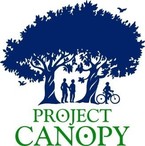
Project Canopy Grants – The Project Canopy Assistance Grant application period is open. These grants are available to state, county, and municipal governments, educational institutions, and non-profit organizations for developing and implementing community forestry projects and programs. This is an ideal opportunity to obtain financial assistance while developing an all-important community preparedness and response plan for invasive insects such as emerald ash borer. For more information see: https://content.govdelivery.com/accounts/MEDACF/bulletins/274be50 or www.projectcanopy.me/grants.
|
District Forester Position Opening – The Department of Agriculture, Conservation & Forestry, Maine Forest Service, has a current vacancy for a District Forester in Jefferson, Maine. This is a full-time permanent position and the application process is open through January 24, 2020. More information can be found in this bulletin https://content.govdelivery.com/accounts/MEDACF/bulletins/274d9df#link_3 or on the website http://www.maine.gov/nrsc/jobs/index.shtml.
Address Change – The mailing address of the Old Town Regional Office of the Maine Forest Service, which houses staff from all three Maine Forest Service divisions (Forest Protection, Forest Policy & Management, Forest Health & Monitoring) has changed due to discontinuation of post office box rental. Effective immediately, mail for that facility should be addressed to Maine Forest Service, 87 Airport Road, Old Town, ME 04468.
Jan 14–16: Maine agricultural trades show, Augusta Civic Center, 76 Community Dr, Augusta, ME 04330
Jan 15: Forest insect update at Maine Woodland Owners Meeting, 2:30–3:15 https://www.mainewoodlandowners.org/annual-meeting
Jan 16: “The Role of Insects in the Forest” talk at the South Portland Public Library, 6:30–8pm, 482 Broadway, South Portland, ME 04106
Jan 22: Invasive forest insects talk at Wells Nature Reserve, 12–1, Mather Auditorium, Wells National Estuarine Research Reserve, 342 Laudholm Farm Road, Wells ME 04090
Jan 23: Browntail Moth Information Session, Belfast boathouse, 4–6 pm, 34 Commercial St, Belfast, ME 04915
Feb 19: Browntail Moth Information Session. Maine Coastal Islands NWR, 6:30 pm, 9 Water Street, PO Box 1231, Rockland, ME 04841, Snow date Feb 26 @ 6:30 PM
Feb 25: Browntail Moth Information Session, Hampden Garden Club, Kiwanis Club, 55 Main St North, Hampden, ME 11:30am
Mar 24: Maine Invasive Species Network Annual Meeting, Colby College, Waterville, ME https://extension.umaine.edu/invasivespecies/
Mar 26–29 : Maine Flower Show, Brick South Building, 8 Thompson's Point Road, Portland, Maine 04102
Office hours are 7:30 am to 4:00 pm, Monday through Friday, except for holidays. Because this is a secured building, you should call ahead to make sure someone will be present to meet with you: (207) 287-2431.
NOTE: The Augusta office is now housed in the Deering Building, 90 Blossom Lane, Suite 201. The mailing address and phone numbers are unchanged. A map is available on our website, https://www.maine.gov/dacf/mfs/forest_health/contact_us.html. The lab at 50 Hospital Street is currently housing the Kennebec County Soil and Water Conservation District.
Conditions Report No. 1, 2020
On-line: https://www.maine.gov/dacf/mfs/publications/condition_reports.html
Department of Agriculture Conservation & Forestry
Maine Forest Service – Forest Health and Monitoring
Contributors: Aaron Bergdahl, Allison Kanoti, Mike Parisio, Thomas Schmeelk, and Colleen Teerling
Unless otherwise noted, photos by Maine Forest Service, DACF
|